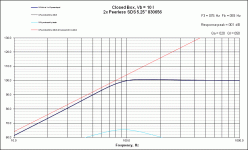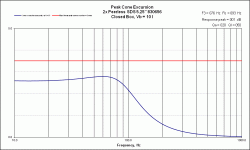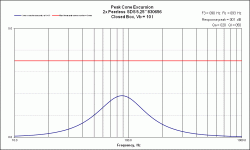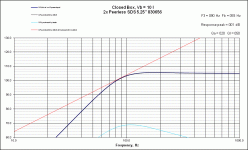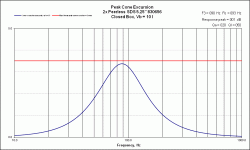I'm building a few speakers for HT use and thought I'd figured everything out enough to order drivers and start modelling a box in Unibox. I did all that and failed to notice the power handling, SPL, excursion, and low frequency extension I'd get from the combination I'd settled on.
And of course I already have all the drivers in hand.
Would it be right to assume your average 5.25" midwoofer is limited to something like 20watts of full-range power? The relationship between xmax (excursion) and SPL isn't a difficult one for me to grasp, but the power rating of the driver (in this case, 60watts "Music" power) and the resulting limits of a standard .707 QTC closed box seem terribly disappointing.
If it helps, the driver is the cheap Peerless 830656 and the published specs are:
FS: 58Hz
85dB at 1w/1m
Xmax: 3.5mm
SD: 86.6cm
Unibox is showing a "safe" cone excursion limit of only 24watts for a 9.5litre volume with 2 drivers in parallel (QTC of .932):

So even if I use the high pass in my home theatre receiver, I'm still looking at something like a max of 30 watts to this channel. Is that normal?
And of course I already have all the drivers in hand.
Would it be right to assume your average 5.25" midwoofer is limited to something like 20watts of full-range power? The relationship between xmax (excursion) and SPL isn't a difficult one for me to grasp, but the power rating of the driver (in this case, 60watts "Music" power) and the resulting limits of a standard .707 QTC closed box seem terribly disappointing.
If it helps, the driver is the cheap Peerless 830656 and the published specs are:
FS: 58Hz
85dB at 1w/1m
Xmax: 3.5mm
SD: 86.6cm
Unibox is showing a "safe" cone excursion limit of only 24watts for a 9.5litre volume with 2 drivers in parallel (QTC of .932):

So even if I use the high pass in my home theatre receiver, I'm still looking at something like a max of 30 watts to this channel. Is that normal?
3.5mm Xmax allows this driver to work as a mid/bass unit.
But it has quite limited SPL capability.
Both Voice Coil dissipation and Xmax are limiting this sealed box driver.
If you were prepared to use a bass only speaker to extend the bass response you could apply a filter to protect the little speaker from damage.
60W music power may mean a 20W to 30W limit for your driver. That puts the sealed box Xmax limit right in the ballpark.
You could use a 40W to 60W amplifier and use your ears to minimise distortion and save your speaker from damage.
But it has quite limited SPL capability.
Both Voice Coil dissipation and Xmax are limiting this sealed box driver.
If you were prepared to use a bass only speaker to extend the bass response you could apply a filter to protect the little speaker from damage.
60W music power may mean a 20W to 30W limit for your driver. That puts the sealed box Xmax limit right in the ballpark.
You could use a 40W to 60W amplifier and use your ears to minimise distortion and save your speaker from damage.
Last edited:
Generally ..The smaller the closed box = more SPL/ power handling, less bass extension.
tuned box needs added steep HP filters to allow max power SPL
tuned box needs added steep HP filters to allow max power SPL
for a specific driver the smaller the box the higher the bass power handling and the less the bass extension.The smaller the closed box = more SPL/ power handling, less bass extension
The maximum bass SPL is controlled by the Xmax and does not change.
Above the bass region the power handling and the SPL are not affected by the box size.
Its a trade-off bass Vs loudness E.g. the smaller closed box has higher F-3dB so it allows more power / SPL to reach Xmax. this can be clearly seen on Unibox plots check it out.The maximum bass SPL is controlled by the Xmax and does not change..
The upper power limits are thermal (melted insulation / glue) sadly marketing likes /uses these numbers.
Last edited:
Why are you concerned about not using enough power? In fact, the less power that you can use the better.
What you should really be looking at is the SPL at xmax, which in this case will be about 102dB @ 1m with 2 drivers in parallel per speaker (depending on speaker placement, you may lose upwards of 6dB to baffle step loss but you get the 6dB back by using a second speaker). Unless you have an exceedingly large room or a strong desire to irreparably damage your hearing, that should be sufficient.
Understand also that xmax is the limit under which the coil remains in the magnetic gap. You can still send the driver more power if you must until the driver reaches its mechanical or thermal limits (which are higher than xmax) but at the expense of more distortion and compression.
What you should really be looking at is the SPL at xmax, which in this case will be about 102dB @ 1m with 2 drivers in parallel per speaker (depending on speaker placement, you may lose upwards of 6dB to baffle step loss but you get the 6dB back by using a second speaker). Unless you have an exceedingly large room or a strong desire to irreparably damage your hearing, that should be sufficient.
Understand also that xmax is the limit under which the coil remains in the magnetic gap. You can still send the driver more power if you must until the driver reaches its mechanical or thermal limits (which are higher than xmax) but at the expense of more distortion and compression.
So, if you port, you'll get more bass, but less SPL. If you can get an f3 of around 80 Hz with a sealed cabinet, you'll be meeting the THX specifications. 30 watts of limited range is a lot louder than 30 watts full range. You are moving the big excursion requirements to the subwoofer, just make sure you have enough subwoofer. 🙂
Best,
Erik
Best,
Erik
Would it be right to assume your average 5.25" midwoofer is limited to something like 20watts of full-range power?
pretty much for 5" sized speakers, 2-3 times more for a decent 7"
Limit the low frequencies with smaller boxes or high-pass filters opens things up.
For two drivers in parallel, then your HT amp starts becoming breathless too at 3.x ohms.
I think 'music power' is more or less an amplifier power suggestion, depending on music and volume position some nastiness can be tolerated.
Last edited:
So even if I use the high pass in my home theatre receiver, I'm still looking at something like a max of 30 watts to this channel. Is that normal?
You can't expect much from a 5" driver.. A pair will go fairly loud, but of you want disco levels, you are going to need something bigger.
I have an MTM that uses 5" drivers (2mm xmax) and when used with a sub with the speakers set small they can reach satisfying levels, but they are still limited below 200Hz.
The Goldenear Triton 7 is a 5" MTM and it does OK, but not in large rooms....
Basically, the rated power handling figure is a thermal figure that has nothing to do with low frequencies. You also need to have reasonable expectations. If you were driving these speakers with 60W RMS, music peaks would probably be over 600Watts. On the flip side, if you have a 100W amplifier and you aren't clipping it, you probably are listening at less than 10W RMS anyway, so....
Hi,
Remember that if you implement classic 4th order L/R
And use 4th order L/R on the sub you need to add 2nd
order BW high pass electrical to the the box roll-off,
which is also 2nd order BW high pass, acoustic.
Your power handling will effectively be much larger.
Two of those Peerless drivers highpassed will handle
the output of the majority of multichannel AV amps.
rgds, sreten.
Remember that if you implement classic 4th order L/R
And use 4th order L/R on the sub you need to add 2nd
order BW high pass electrical to the the box roll-off,
which is also 2nd order BW high pass, acoustic.
Your power handling will effectively be much larger.
Two of those Peerless drivers highpassed will handle
the output of the majority of multichannel AV amps.
rgds, sreten.
Thanks all for the replies!
I will definitely be using the "small" setting on my HT Receiver for these. I may also have the ability to set the x-over freq. That's a setting in my Denon receiver I haven't played with yet.
Yes, will be using a 12" sub I'll be building around the same time (a Rythmik sealed unit) and the mains will be 6.5" drivers. And it's very possible sub 150Hz content is rare for a center channel. I'm not sure about that one.
I'm glad this is fairly common for drivers this small and I won't worry about it so much.
Yes, 100dB is very loud and no, my room is not large. I was more concerned about the very low output that I'd be feeding to this channel and the potential for damaging the speaker.
I was also surprised by how little low freq extension was offered below the driver's xmax. Most models are showing 150Hz as the limit. Unless my HT receiver gives me some control over slope and freq, I think I'm probably limited to 80Hz, which isn't high enough.
I'll likely go sealed as I plan to do the same for the mains and the design is much simpler to get right. That and vented scares me with the excursion models showing crazy stuff below the tuning freq. I'd be happier not to risk it.
I think my next center will use the same drivers as my mains....
I will definitely be using the "small" setting on my HT Receiver for these. I may also have the ability to set the x-over freq. That's a setting in my Denon receiver I haven't played with yet.
Yes, will be using a 12" sub I'll be building around the same time (a Rythmik sealed unit) and the mains will be 6.5" drivers. And it's very possible sub 150Hz content is rare for a center channel. I'm not sure about that one.
I'm glad this is fairly common for drivers this small and I won't worry about it so much.
Yes, 100dB is very loud and no, my room is not large. I was more concerned about the very low output that I'd be feeding to this channel and the potential for damaging the speaker.
I was also surprised by how little low freq extension was offered below the driver's xmax. Most models are showing 150Hz as the limit. Unless my HT receiver gives me some control over slope and freq, I think I'm probably limited to 80Hz, which isn't high enough.
I'll likely go sealed as I plan to do the same for the mains and the design is much simpler to get right. That and vented scares me with the excursion models showing crazy stuff below the tuning freq. I'd be happier not to risk it.
I think my next center will use the same drivers as my mains....
setting up the Satelite speaker to an acoustic B2 is a very powerful tool
the "small" output is likely to be a 2pole high pass filter.
They tell you it is 80Hz. It is also likely to be a Butterworth roll-off (B2).
If you make the speaker acoustic rolloff also an 80Hz B2, then the combination of the "small" and the acoustic make an 80Hz LR4.
If you cannot get the speaker down to 80Hz AND a B2, then you cannot get an LR4.
If you want to aim for the LR4 as suggested by Sreten (post10) you need to tune your speaker to a B2 roll-off and find it's frequency (xF-3dB). Then set your HT to "big" and add an electrical xF-3dB B2 before your amplifier and combine that with the acoustic to create an xF-3dB LR4 high pass.
This electrical B2 will help protect your little driver. The electrical filter does not increase it's power handling. The high pass filter attenuates the LF content of the wideband signal and as a result you limit the cone excursion to less than Xmax for the same SPL of the combined bass+satelite. Hornresp now has a filter + acoustic combination option to let you see what the filtered satelite performance will be like.
the "small" output is likely to be a 2pole high pass filter.
They tell you it is 80Hz. It is also likely to be a Butterworth roll-off (B2).
If you make the speaker acoustic rolloff also an 80Hz B2, then the combination of the "small" and the acoustic make an 80Hz LR4.
If you cannot get the speaker down to 80Hz AND a B2, then you cannot get an LR4.
If you want to aim for the LR4 as suggested by Sreten (post10) you need to tune your speaker to a B2 roll-off and find it's frequency (xF-3dB). Then set your HT to "big" and add an electrical xF-3dB B2 before your amplifier and combine that with the acoustic to create an xF-3dB LR4 high pass.
This electrical B2 will help protect your little driver. The electrical filter does not increase it's power handling. The high pass filter attenuates the LF content of the wideband signal and as a result you limit the cone excursion to less than Xmax for the same SPL of the combined bass+satelite. Hornresp now has a filter + acoustic combination option to let you see what the filtered satelite performance will be like.
Last edited:
First, yes there is lots of content below 150Hz in the CC and in fact many people don't appreciate that most movie content comes from the CC alone. But that still shouldn't be a problem in your situation because...
Second, I'm not sure that you are fully understanding all of Unibox's graphs yet or perhaps the relationship between xmax, LF extension and SPL. Specifically, you can't really talk about xmax without talking about SPL but LF extension is not dependent on either one of those. Let's look at some more graphs, all with 2 of your Peerless 5.25" in parallel in 10L sealed (walls covered; no leaks).
Chart 1 & 2 - SPL above about 100Hz is about 100dB/1m with 7W to each driver. Very loud. F3 is about 76Hz, F6 is about 63Hz and F10 is about 50Hz and won't change as you turn the volume knob up and down. Now I'm not sure that you are getting this so notice that xmax is not exceeded no matter what frequency you send it at these SPL's (and below). Feed it 20Hz and cone excursion is only going to be about 2.6mm albeit at only about 73dB which means that you could actually run them as a 'large' speaker if you wanted and even direct the subwoofer output to the CC as well and you are still not going to exceed the drivers' xmax at about 100dB/1m (not of course that that's actually a good idea without a real sub if you actually want to hear any of the lowest frequencies).
Now to mirror what others have also written, if your receiver has a Butterworth HP filter at 80Hz things only get better. (Unibox can also import external filters btw. I create them with Response Modeler. Give it a try.)
Chart 3 & 4 - So this is with the B2 80Hz filter added in still at 7W per driver and still about 100dB/1m and cone excursion below about 100Hz is very much reduced. So much so that you can now play them even louder if you want....
Chart 4 & 5 - Still with the B2 80Hz filter but now with 22W to each driver before excursion of each driver nears xmax. SPL this time is up to 105dB which again is more than you are probably ever going to need.
And don't forget that xmax is not the driver's limit, it's only the limit before sound quality is significantly compromised.
Moral of the story: LF extension of a driver is box and alignment dependent, independent of SPL. Xmax on the other hand is both frequency dependent (so, dependent on a HP filter for eg as well as box alignment) as well as SPL dependent.
Hope that helps.
Second, I'm not sure that you are fully understanding all of Unibox's graphs yet or perhaps the relationship between xmax, LF extension and SPL. Specifically, you can't really talk about xmax without talking about SPL but LF extension is not dependent on either one of those. Let's look at some more graphs, all with 2 of your Peerless 5.25" in parallel in 10L sealed (walls covered; no leaks).
Chart 1 & 2 - SPL above about 100Hz is about 100dB/1m with 7W to each driver. Very loud. F3 is about 76Hz, F6 is about 63Hz and F10 is about 50Hz and won't change as you turn the volume knob up and down. Now I'm not sure that you are getting this so notice that xmax is not exceeded no matter what frequency you send it at these SPL's (and below). Feed it 20Hz and cone excursion is only going to be about 2.6mm albeit at only about 73dB which means that you could actually run them as a 'large' speaker if you wanted and even direct the subwoofer output to the CC as well and you are still not going to exceed the drivers' xmax at about 100dB/1m (not of course that that's actually a good idea without a real sub if you actually want to hear any of the lowest frequencies).
Now to mirror what others have also written, if your receiver has a Butterworth HP filter at 80Hz things only get better. (Unibox can also import external filters btw. I create them with Response Modeler. Give it a try.)
Chart 3 & 4 - So this is with the B2 80Hz filter added in still at 7W per driver and still about 100dB/1m and cone excursion below about 100Hz is very much reduced. So much so that you can now play them even louder if you want....
Chart 4 & 5 - Still with the B2 80Hz filter but now with 22W to each driver before excursion of each driver nears xmax. SPL this time is up to 105dB which again is more than you are probably ever going to need.
And don't forget that xmax is not the driver's limit, it's only the limit before sound quality is significantly compromised.
Moral of the story: LF extension of a driver is box and alignment dependent, independent of SPL. Xmax on the other hand is both frequency dependent (so, dependent on a HP filter for eg as well as box alignment) as well as SPL dependent.
Hope that helps.
Attachments
Thanks again all! Very good and helpful info here.
Firstly, I've done a bit more research into my HT Receiver (A Denon AVR-4306) and have discovered it's got a few selectable crossover points from 200 to 80Hz. So there's quite a lot of flexibility here. I don't know the slopes on these but I'd guess a B2 is pretty safe, given the standard practice.
I don't want to go with a pre-level crossover to the channel as that would introduce a lot more complexity to my setup. Not the least of which is that my setup doesn't include a seperate preamp anywhere in the chain that I can get to. And given there's a lot to work with on the receiver, I'll stick with what I've got.
jReave, your timing was great! I'd made that same assumption probably around the time you'd posted your reply. I'd already modeled the rolloff using Response Simulator and had come to the very same conclusion about my little speakers being quite safe, so long as I model the response properly and pick the right "small" setting from the receiver.
Sounds like I'm all set!
One last item to mention - this all came about because I made the same mistake I'm guessing a lot of folks do: Thinking the output power of my receiver needs to exactly match the power handling ability of the speakers it's meant to drive. What I didn't account for was that the ouput volume will far exceed my ear's ability to deal with, WAY before I get to any sort of "high" power output of the amplifier.
Hope all this helps the next person with a similar question. Great help and great advice here.
Firstly, I've done a bit more research into my HT Receiver (A Denon AVR-4306) and have discovered it's got a few selectable crossover points from 200 to 80Hz. So there's quite a lot of flexibility here. I don't know the slopes on these but I'd guess a B2 is pretty safe, given the standard practice.
I don't want to go with a pre-level crossover to the channel as that would introduce a lot more complexity to my setup. Not the least of which is that my setup doesn't include a seperate preamp anywhere in the chain that I can get to. And given there's a lot to work with on the receiver, I'll stick with what I've got.
jReave, your timing was great! I'd made that same assumption probably around the time you'd posted your reply. I'd already modeled the rolloff using Response Simulator and had come to the very same conclusion about my little speakers being quite safe, so long as I model the response properly and pick the right "small" setting from the receiver.
Sounds like I'm all set!
One last item to mention - this all came about because I made the same mistake I'm guessing a lot of folks do: Thinking the output power of my receiver needs to exactly match the power handling ability of the speakers it's meant to drive. What I didn't account for was that the ouput volume will far exceed my ear's ability to deal with, WAY before I get to any sort of "high" power output of the amplifier.
Hope all this helps the next person with a similar question. Great help and great advice here.
- Status
- Not open for further replies.
- Home
- Loudspeakers
- Multi-Way
- Relationship between enclosure size, low frequency extension, excursion, and SPL
